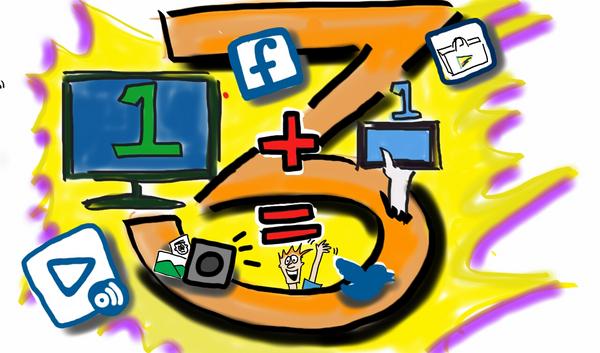But What Does Multi-Screen Content Mean?
Welcome to the era of multi-screen. The average U.S. household owns five connected devices (Chetan Sharma) – and many of those screens are being used simultaneously for entertainment and information. According to Nielsen, 88 percent of tablet owners and 86 percent of smartphone owners said they used their device while watching TV at least once during a 30-day period; 45 percent of tablet owners said at least once a day and 26 percent of said several times a day. Powerful data like this illustrates why multi-screen content is a hot topic for forward-thinking marketers and advertisers.
Last week I attended the MultiScreen Summit in Hollywood, a two-day conference designed to educate industry executives on how to deliver compelling and profitable multi-screen content and services. What sounds like an easy lesson in creative marketing is in fact a complex world that is heavily reliant on consumer interest and fandom, making multi-screen content development a fluid market.
We think of the monetization of second screen content as a new phenomenon, brought on by the sophistication of today’s mobile user, but did you know the third-party download of wallpapers, ringtones and games was first instituted to monetize “content” for the mobile phone? Sure, mobile games like Snake seem archaic compared to Angry Birds, but its success paved the way for second screen content.
With two full days of keynotes and panels featuring big names brands like FOX, Samsung, Klout, RadiumOne, NASCAR, Viggle and PlayStation, it’s difficult to narrow in on an overarching message, but I think Gary Schwartz, content chair for the MultiScreen Summit and North American chair of the Mobile Entertainment Forum, summarized best during his opening remarks:
- The definition of mobile has changed – it’s not just a handheld device, it’s a connected device
- Human interface and narrative will drive the successful monetization of second screen content, not technology
Multi-screen content is also an added value opportunity for marketers: 1+1 = 3, where mobile content can seamlessly integrate with TV content to drive an experience.

An artist sketched ideas from the day one panels and live-tweeted from the summit. On a second screen, of course. Check out some of the illustrative posts at @connectedscreen.
Key Learnings for Developing Second Screen Content
If you are considering second screen content for your brand, a few things to keep in mind:
- Content and context (relevance) are key to driving user engagement
- Content isn’t about the number of impressions you buy, but the impression you make
- Is your content brand, product or action focused? All about the right time, on the right screen
- Content is king, but multi-screen is queen (according to a recent Google study, heavily referenced at the event)
- Despite the explosion of mobile content, it’s important to remember that for the majority of users, mobile devices are tools first and entertainment destinations second
- Mobile video consumption is typically user generated content (UGC) that is viewed to keep up with friends and pop culture trends
- Content format, length and topic should vary based on consumer habits
- Brands and technologies can work together to develop platform-specific content; i.e. bite size content for smartphone users, short-form content for tablets
Category-Specific Takeaways
Television
- Second screen content for TV programming is more about enhancing the primary screen experience, amplifying engagement and brand recognition
- TV is linear, but with additional devices, networks are driven to develop more content to meet the consumer needs – Sunday night’s Tracy Morgan stunt at the Emmys highlights the merging of two screens.
Gaming
- The gaming fan base is unlikely to positively respond to straight ad placements
- Due to the nature of the audience, advertising is difficult in hardcore gaming – likened to product placement in “The Lord of the Rings” – it’s just unnatural
- Second screen content makes more sense, as there’s opportunity to organically engage fans on another device without intrudin
- Free-to-play models have seen success with micro transactions but will soon be forced to think outside the box
- Marketers are encouraged to create relationships that live inside the game or on a second screen, expanding the fan base
Sports
- Sports fans are more likely to engage with long-form content on multiple devices and are hungry for as much as they can find
- Along with news and children’s programming, sports is a genre where long-form content can be successful on any device
Mobile Wallets
- In the feistiest panel of the event (which spurred Jerry Springer-like confrontations), mobile wallets were identified as an emerging industry we’ll see much more of in the future, and it’s up for grabs
- From PayPal to Apple’s new Passbook, it’s about control, as evidenced by Richard Crone’s oft-repeated mantra: “the one who enrolls, controls”
Panelists also made a point to take note of best-in-class brands that understand the multi-screen strategy and effectively reach their target audience, including Lexus, American Express and Twitter, Amazon, GRAMMY Awards, USA Network and HBO GO.
So what is the future of multi-screen content? Brands are beginning to recognize the value in multi-screen content, but the concept is still in its infancy and the risk is high. Technology will play a role in dictating how brands implement their strategy, but ultimately, content availability and consumer behavior will drive the success of the multi-screen movement.
For some perspective, Short Message Service (SMS text) has been around for more than 20 years, but many Fortune 500 companies are just now adding mobile elements into their programs. Panelist Coleman Breland of Turner Broadcasting Systems said it best: “As marketers, we can control the direction, but we can’t control how long it takes to get there.”